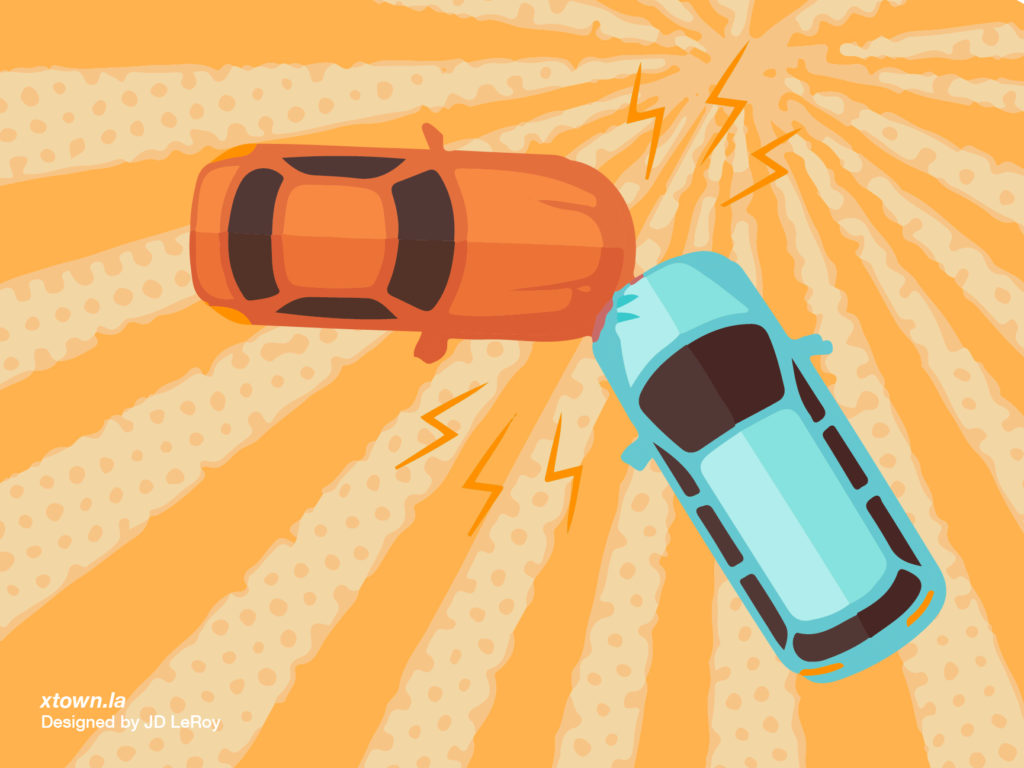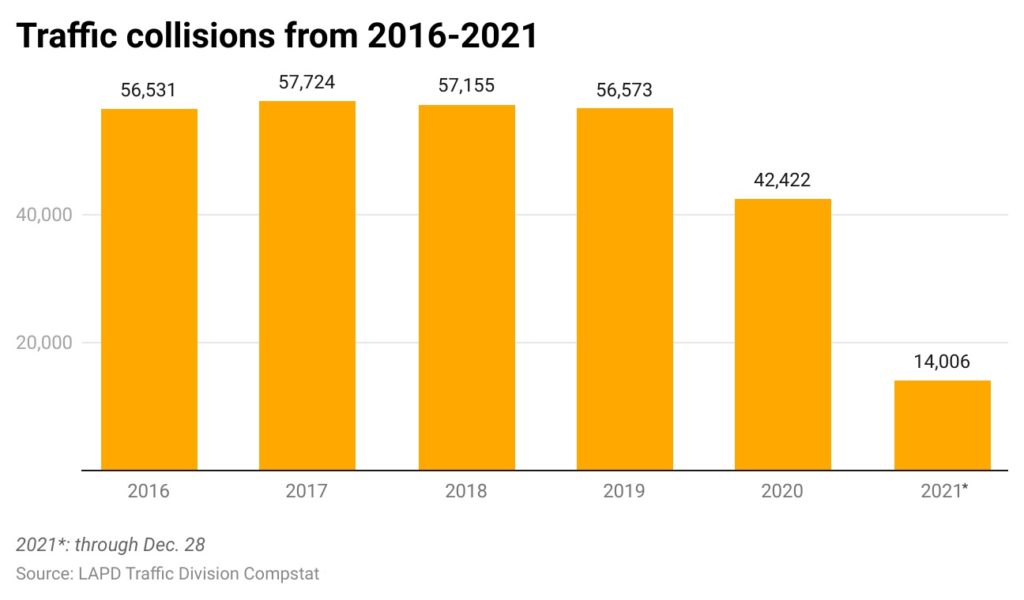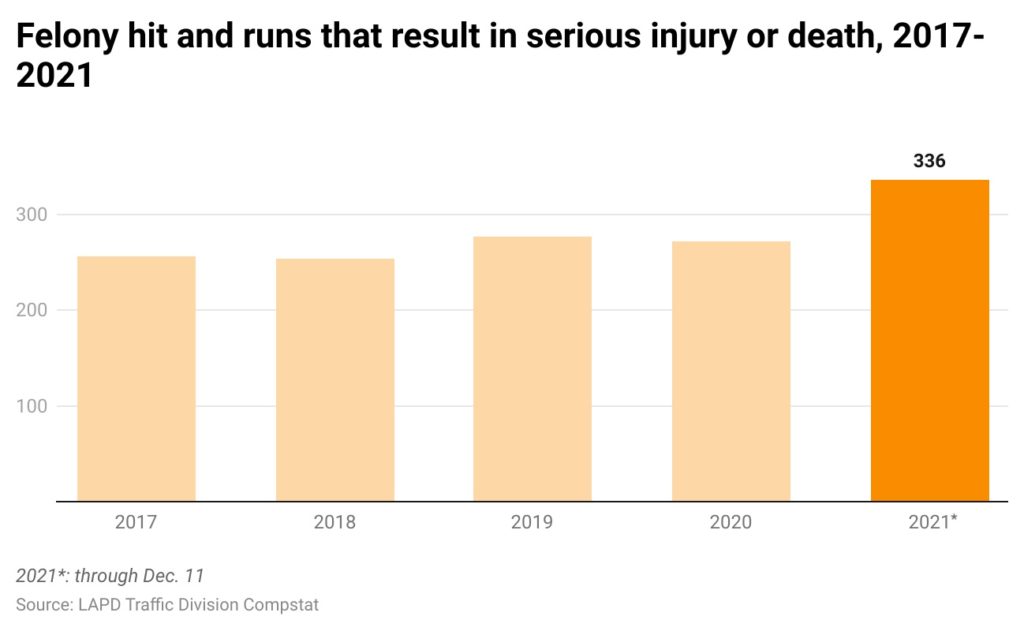More people are dying in Los Angeles car collisions

At about 3 p.m. on Dec. 11, Arian Rahbar was crossing Jefferson Boulevard in South Los Angeles. Suddenly, a Dodge Challenger came speeding down the street. Rahbar, a 21-year-old USC student, was struck, even though he was in a marked crosswalk. He would die of his injuries.
“Witnesses heard two cars revving their engines at a traffic light nearby, and then saw them heading east on Jefferson,” LAPD Chief Michel Moore told the Los Angeles Police Commission on Dec. 14 (two men were arrested in connection with the death). Rahbar, Moore said, was “an individual who had a bright future, and street racing took that away in a moment.”
Rahbar’s death was tragic, but not an anomaly. It marked the 101st traffic-related fatality within the department’s South Traffic Division this year. Only a few hours later, that number would grow. According to LAPD Det. Ryan Moreno, two women experiencing homelessness were hit by a vehicle.
This string of deaths from car crashes is part of a disturbing trend in Los Angeles. As of Dec. 11, there had been 277 traffic fatalities, according to LAPD Traffic Division Compstat data. That is an increase of 20% over the same time period last year, and a 17% boost over the 236 deaths in the equivalent timeframe in the pre-pandemic year of 2019.
Moreno, who has been with the department for 26 years, said he’s never seen numbers like this before. He attributed the rise in fatal crashes to a combination of excessive speed and aggression.
“This is a whole different level of disrespectful driving,” he said.
[Get COVID-19, crime and other stats about where you live with the Crosstown Neighborhood Newsletter]
Nationwide problem
Los Angeles is not the only city where the roads are becoming more dangerous. The National Highway Traffic Safety Administration previously reported that 8,730 people across the country died in motor vehicle crashes in the first three months of 2021, a 10.5% increase over the 7,900 traffic deaths in the same period in 2020. It noted that the rise in fatalities occurred even as driving decreased during the pandemic.
The NHTSA said that the increase appears to stem from drivers engaging “in more risky behavior, including speeding, failing to wear seatbelts, and driving under the influence of drugs or alcohol.”
Of the LAPD’s four geographic areas, the South Traffic Division is experiencing the most death. As of Dec. 21, it had recorded 103 fatalities, including both collisions and people hit by vehicles.
Moreno said Rahbar, like an alarming number of victims, was following the rules, while drivers too often break them. This includes not only racing, but distracted driving, such as people texting when behind the wheel.
“It’s unfortunate, because we have a lot of victims that actually do everything right,” Moreno said. “[Rahbar] did everything right. He waited, he was at a marked crosswalk.”
New reporting system
From Jan. 1-Dec. 23, the city recorded more than 14,000 traffic collisions, according to Los Angeles Police Department data. The figure is difficult to compare to previous years, as in February the LAPD introduced an online self-reporting platform, the Community Online Reporting System, for collisions that do not involve a serious injury or death.
From 2016-2019, the city reported approximately 55,000 collisions per year. The number fell in 2020 due to decreased driving during the pandemic.

2021 also reflects the year LAPD introduced an online self-reporting system for minor collisions
Fleeing the scene
City leaders have long sought to make the roads safer for all. Every year since 2016, more than 200 people have been killed by cars in Los Angeles.
In 2015, Mayor Eric Garcetti launched Vision Zero, an effort to eliminate traffic deaths by 2025. The initiative included traffic calming measures such as installing high visibility crosswalks and speed feedback signs that tell drivers how fast they’re going.
Yet Vision Zero has failed to achieve Garcetti’s aim, and instead deaths, as well as serious injuries from traffic collisions, are increasing. That includes people hit by vehicles. According to Traffic Division data, through Dec. 11, 464 pedestrians in the city had been seriously injured by a car, and 125 had died. The figures at the same point last year were 350 serious injuries and 117 deaths.
Felony hit and runs that cause serious injury or death are also up this year, according to Traffic Division data. From Jan. 1-Dec. 11, there were 336 felony hit and runs resulting in a serious injury or death, a 23.5% increase over the 272 in the same timeframe in 2020. At the Police Commission meeting, Moore said this figure has been steadily rising for several years; at an equivalent point in 2018, there had been 254 serious injuries or deaths.

“The instances of people who involve themselves in an accident, and then turn it into a crime by fleeing the scene, has increased year over year,” Moore said at the meeting.
Search for solutions
Damian Kevitt lost his right leg in a hit-and-run crash. He was biking in Griffith Park when he was struck by a speeding vehicle and pinned underneath the car. Kevitt, who founded and is executive director of the advocacy group Streets Are For Everyone, said it is frustrating to see how long traffic-calming projects take to be completed, especially in South Los Angeles.
“The stats are getting worse,” Kevitt said. “You’ve got so many streets that are so dangerous and it takes years and years for a street to be upgraded.”
Kevitt pointed to slow progress in installing speed humps, asserting that there is a lack of political will when it comes to road safety.
“To the extent that we’re complacent about it, is to the extent that people will die,” he said.
How we did it: We examined traffic data from the Los Angeles Police Department and its Traffic Division. Learn more about our data here.
LAPD data only reflects crimes or incidents that are reported to the department, not how many crimes actually occurred. In making our calculations, we rely on the data the LAPD makes publicly available. LAPD may update past crime reports with new information, or recategorize past reports. Those revised reports do not always automatically become part of the public database.
Have questions? Email us at askus@xtown.la.






